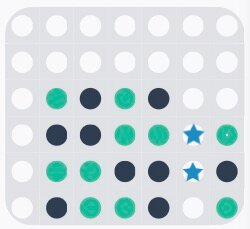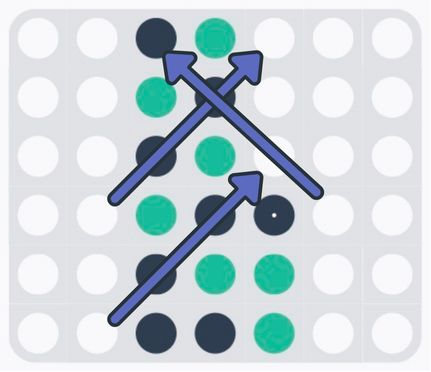Connect 4 Advanced Guide
Welcome to the Connect 4 Advanced Guide! This guide is tailored for players who have grasped the basic rules and strategies of Connect 4 and are looking to elevate their game. We'll delve into complex tactics, pattern recognition, and strategic planning to give you an edge over your opponents on papergames.io.
Advanced Understanding of Connect 4
Connect 4 is not just about connecting four discs; it's about outsmarting your opponent by thinking several moves ahead. Mastery involves understanding the nuances of the game, recognizing patterns, and predicting your opponent's moves.
Advanced Strategies
Horizontal vs. Vertical vs. Diagonal Prioritization
In advanced Connect 4, understanding when to prioritize horizontal, vertical, or diagonal connections can significantly influence your gameplay. Here are some examples to illustrate this concept:
Horizontal Prioritization:
- Example: If you have two discs at the bottom of columns 3 and 4, and your opponent has no discs blocking columns 2 and 5, prioritize placing your discs in columns 2 and 5 to create a horizontal four-in-a-row threat.
- Strategy: Horizontal lines are more visible and easier to complete, but also easier for opponents to block. Use them when you have a clear path to victory.
In this example, the player with the dark piece blundered by not blocking the threat in columns 3 or 5. The player with light pieces enjoyed the situation with a move on the 5th column, leading to a forced win.
Vertical Prioritization:
- Example: When you have two discs stacked in column 4 and no opponent discs in the same column, focus on filling this column to create a vertical threat.
- Strategy: Vertical connections are less obvious to opponents, especially when built from the bottom of the grid. They are a strong choice when you control a column.
This example shows that the dark-squared player enjoys a comfortable position with control on the central column.
Diagonal Prioritization:
- Example: If you have a diagonal setup with discs in the bottom of columns 2 and 3, and in the second row of column 4, focus on extending this diagonal either upwards or downwards depending on the board's state.
- Strategy: Diagonal lines are the hardest for opponents to spot and block. They should be prioritized when you have the opportunity to build them subtly.
This example shows that the light-piece player creates a diagonal with 3 connected pieces, causing a potential threat during the game.
These examples show the importance of recognizing the state of the board and choosing the type of connection that maximizes your chances of winning while minimizing your opponent's opportunities.
Forced Moves and Double Threats
In Connect 4, mastering the art of forcing your opponent into making moves that benefit you, and creating double threats, can significantly enhance your chances of winning.
Forced Moves
- Example: If you have three discs in a line with an open slot at the end, your next move should force your opponent to block this slot. This can often lead to a double threat.
- Strategy: Use forced moves to control your opponent's actions, limiting their options and setting up favorable conditions for yourself.
Double Threats
- Example 1: You have two options to create a line of four, one horizontally and one vertically, and your opponent can only block one. For instance, if you have three discs in a row in columns 2, 3, and 4, and two discs stacked in column 3, your opponent cannot block both the horizontal and vertical win.
- Example 2: Create a setup where you have two potential diagonals to win. For example, discs placed in a zig-zag pattern across columns 2, 3, 4, and 5, where completing either diagonal leads to a win.
- Strategy: Double threats are powerful because they give you two different paths to victory. The opponent can only block one, ensuring you can win in the next move.

This example shows the light-piece player has a forcing move on column 7. If the light-piece player tries to block the first threat (column 7, row 2), the light-piece player can respond with a winning move (column 7, row 3.
Creating and exploiting these situations requires foresight and the ability to predict your opponent's moves. Practice these tactics in your games on papergames.io to become adept at forcing moves and creating double threats.
Blocking and Counter-Play
Learn to anticipate your opponent's strategy and effectively block their attempts to connect four while setting up your line.
In-Depth Analysis
Positional Awareness:
- Upper Layer Control: The top rows of the board are as crucial as the bottom ones. Control these to limit your opponent’s options.
- Center Column Dominance: Owning the center column gives a significant advantage due to the maximum number of connective possibilities.
Pattern Recognition
Mastering Connect 4 requires the ability to recognize and utilize various patterns. These patterns, once identified, can be used to set traps or create multiple winning opportunities.
Horizontal Patterns
- Three-in-a-Row: Look for opportunities where you have three discs in a row with an open slot on either end. This setup forces your opponent to block one end, allowing you to win by playing on the other.
Vertical Patterns
- Stacked Three: Having three discs stacked in a column provides a direct threat of winning in the next move. It forces your opponent to block the top, often creating opportunities elsewhere.
- Alternate Stacking: Placing discs alternately between two columns. This can lead to a scenario where you have two potential vertical fours, making it difficult for your opponent to block both.
Diagonal Patterns
- Ascending/Descending Diagonal: A diagonal setup where you have three of your discs in a diagonal line, with an opportunity to extend it at either end.
- Diagonal with a Gap: Similar to the broken three in horizontal patterns, but in a diagonal line. Filling the gap can create a winning opportunity.
Zig-Zag Patterns
Zig-zag patterns in Connect 4 are a sophisticated way to create multiple opportunities for victory. These patterns can confuse your opponent and lead to potential winning moves.
Understanding Zig-Zag Patterns
Zig-zag patterns involve alternating your discs between two or more columns in a staggered manner. This approach can create simultaneous threats in different directions.
Examples of Zig-Zag Patterns
-
Basic Zig-Zag:
- Setup: Place your discs in an alternating pattern across columns. For example, start with a disc in column 3, then in column 4 one row higher, and back to column 3 in the next row up.
- Outcome: This pattern can create a diagonal line threat that can be extended in multiple directions, making it difficult for your opponent to effectively block.
-
Multi-Directional Zig-Zag:
- Setup: Create a zig-zag pattern that extends across three columns. For instance, place discs in columns 2, 3, and 4 in a staggered manner, so they form a zig-zag pattern from the bottom row upwards.
- Outcome: This setup can lead to potential winning moves both horizontally and diagonally, presenting your opponent with a challenging scenario to defend against.
-
Vertical-Horizontal Zig-Zag:
- Setup: Combine vertical and horizontal strategies in your zig-zag pattern. For example, have two discs stacked in column 3, then place discs in columns 2 and 4 at the same level.
- Outcome: This pattern can create a situation where you are one move away from winning both horizontally and vertically, giving your opponent multiple threats to consider.

Strategic Use of Zig-Zag
- Flexibility: These patterns provide flexibility in your gameplay, allowing you to adapt and change your strategy based on your opponent's moves.
- Creating Double Threats: Zig-zag patterns can often lead to double threats, forcing your opponent to choose which line to block and leaving the other open for your win.
- Disguising Your Intentions: A well-planned zig-zag pattern can mask your true intentions, making it harder for your opponent to predict your next move.
Recognizing Opponent’s Patterns
- Defensive Awareness: Be vigilant about your opponent's potential patterns. Recognize their setups and intervene before they complete a four-in-a-row.
- Forced Blocking: Sometimes, the best move is to force your opponent to block a potential pattern, giving you control over the board and the game's flow.
Advanced Pattern Utilization:
- Pattern Combinations: Learn to combine different patterns to create complex scenarios. For instance, setting up a potential horizontal four while simultaneously creating a vertical or diagonal threat.
- Disguised Threats: Create patterns that don’t immediately reveal your strategy. These are particularly effective in the mid-to-late game where the board is more filled.
Predictive Thinking
Predictive thinking in Connect 4 involves anticipating future moves, both yours and your opponent's. This forward-thinking approach can significantly improve your decision-making and strategic positioning in the game.
Examples of Predictive Thinking:
-
Anticipating Opponent Moves:
- Scenario: Your opponent has two discs in a row in column 3 and 4 and is likely to add a third.
- Predictive Move: Place your disc above their potential third disc. This not only blocks their line but also sets you up for a potential vertical or diagonal connection.
- Outcome: You prevent your opponent from creating a three-disc line, forcing them to change their strategy, while you create an opportunity for yourself.
-
Setting Up Future Wins:
- Scenario: You have a chance to create three discs in a line but notice that doing so could lead to your opponent forcing a win in their next move.
- Predictive Move: Instead of completing your three-in-a-row, block your opponent's potential winning move first.
- Outcome: By prioritizing defense over immediate offense, you ensure the game continues and can find another route to victory.
-
Multi-Turn Strategy:
- Scenario: Early in the game, you have several scattered discs with no immediate connection.
- Predictive Move: Start creating a zig-zag pattern or setting up potential forks that can be converted into winning moves in subsequent turns.
- Outcome: Although not immediately threatening, these setups become powerful in the mid-to-late game, often catching opponents off-guard.
Tips for Effective Predictive Thinking:
- Think in Turns: Always plan your current move while considering the next one or two turns. This helps in building strategies and countering your opponent effectively.
- Watch for Patterns: Recognize common patterns or traps that opponents may use and plan your moves to counter them.
- Adaptability: Be ready to change your strategy based on the state of the board and your opponent's actions. Flexibility is key in Connect 4.
Practical Application
To truly master these advanced concepts, practical application is key. Engage in games on papergames.io, consciously applying these strategies in real-time scenarios.
Practice Exercises:
- Play against a strong AI opponent to test different strategies.
- Replay your games to analyze your moves and understand where improvements can be made.
Conclusion
Advanced Connect 4 play demands strategic depth, foresight, and adaptability. By incorporating these advanced tactics into your gameplay, you'll be well on your way to mastering Connect 4.
Challenge yourself on papergames.io and experience the thrill of strategic dominance in Connect 4!
🔴🔵🤔🎮